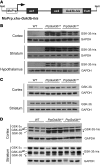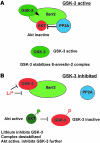Glycogen synthase kinase-3 is essential for β-arrestin-2 complex formation and lithium-sensitive behaviors in mice
- PMID: 21821916
- PMCID: PMC3163947
- DOI: 10.1172/JCI45194
Glycogen synthase kinase-3 is essential for β-arrestin-2 complex formation and lithium-sensitive behaviors in mice
Abstract
Lithium is the first-line therapy for bipolar disorder. However, its therapeutic target remains controversial. Candidates include inositol monophosphatases, glycogen synthase kinase-3 (GSK-3), and a β-arrestin-2/AKT/protein phosphatase 2A (β-arrestin-2/AKT/PP2A) complex that is known to be required for lithium-sensitive behaviors. Defining the direct target(s) is critical for the development of new therapies and for elucidating the molecular pathogenesis of this major psychiatric disorder. Here, we show what we believe to be a new link between GSK-3 and the β-arrestin-2 complex in mice and propose an integrated mechanism that accounts for the effects of lithium on multiple behaviors. GSK-3β (Gsk3b) overexpression reversed behavioral defects observed in lithium-treated mice and similar behaviors observed in Gsk3b+/- mice. Furthermore, immunoprecipitation of striatial tissue from WT mice revealed that lithium disrupted the β-arrestin-2/Akt/PP2A complex by directly inhibiting GSK-3. GSK-3 inhibitors or loss of one copy of the Gsk3b gene reduced β-arrestin-2/Akt/PP2A complex formation in mice, while overexpression of Gsk3b restored complex formation in lithium-treated mice. Thus, GSK-3 regulates the stability of the β-arrestin-2/Akt/PP2A complex, and lithium disrupts the complex through direct inhibition of GSK-3. We believe these findings reveal a new role for GSK-3 within the β-arrestin complex and demonstrate that GSK-3 is a critical target of lithium in mammalian behaviors.
Figures




Similar articles
-
A beta-arrestin 2 signaling complex mediates lithium action on behavior.Cell. 2008 Jan 11;132(1):125-36. doi: 10.1016/j.cell.2007.11.041. Cell. 2008. PMID: 18191226
-
Deletion of GSK3β in D2R-expressing neurons reveals distinct roles for β-arrestin signaling in antipsychotic and lithium action.Proc Natl Acad Sci U S A. 2012 Dec 11;109(50):20732-7. doi: 10.1073/pnas.1215489109. Epub 2012 Nov 27. Proc Natl Acad Sci U S A. 2012. PMID: 23188793 Free PMC article.
-
Looking at lithium: molecular moods and complex behaviour.Mol Interv. 2008 Oct;8(5):230-41. doi: 10.1124/mi.8.5.8. Mol Interv. 2008. PMID: 19015387 Review.
-
Beta-arrestin 2 modulates resveratrol-induced apoptosis and regulation of Akt/GSK3ß pathways.Biochim Biophys Acta. 2010 Sep;1800(9):912-8. doi: 10.1016/j.bbagen.2010.04.015. Epub 2010 May 7. Biochim Biophys Acta. 2010. PMID: 20457218
-
The Akt-GSK-3 signaling cascade in the actions of dopamine.Trends Pharmacol Sci. 2007 Apr;28(4):166-72. doi: 10.1016/j.tips.2007.02.006. Epub 2007 Mar 8. Trends Pharmacol Sci. 2007. PMID: 17349698 Review.
Cited by
-
FXR1P is a GSK3β substrate regulating mood and emotion processing.Proc Natl Acad Sci U S A. 2015 Aug 18;112(33):E4610-9. doi: 10.1073/pnas.1506491112. Epub 2015 Aug 3. Proc Natl Acad Sci U S A. 2015. PMID: 26240334 Free PMC article.
-
Molecular Mechanisms of Lithium Action: Switching the Light on Multiple Targets for Dementia Using Animal Models.Front Mol Neurosci. 2018 Aug 28;11:297. doi: 10.3389/fnmol.2018.00297. eCollection 2018. Front Mol Neurosci. 2018. PMID: 30210290 Free PMC article.
-
Glycogen synthase kinase-3 in the etiology and treatment of mood disorders.Front Mol Neurosci. 2011 Aug 9;4:16. doi: 10.3389/fnmol.2011.00016. eCollection 2011. Front Mol Neurosci. 2011. PMID: 21886606 Free PMC article.
-
Glycogen synthase kinase 3 beta gene structural variants as possible risk factors of bipolar depression.Am J Med Genet B Neuropsychiatr Genet. 2014 Apr;165B(3):217-22. doi: 10.1002/ajmg.b.32223. Epub 2014 Feb 21. Am J Med Genet B Neuropsychiatr Genet. 2014. PMID: 24677591 Free PMC article.
-
Neuroprotective effects of lithium: implications for the treatment of Alzheimer's disease and related neurodegenerative disorders.ACS Chem Neurosci. 2014 Jun 18;5(6):443-50. doi: 10.1021/cn5000309. Epub 2014 May 6. ACS Chem Neurosci. 2014. PMID: 24766396 Free PMC article. Review.
References
-
- Cade J. Lithium salts in the treatment of psychotic excitement. Med J Aust. 1949;2(10):349–352. - PubMed
Publication types
MeSH terms
Substances
Grants and funding
LinkOut - more resources
Full Text Sources
Molecular Biology Databases
Miscellaneous

